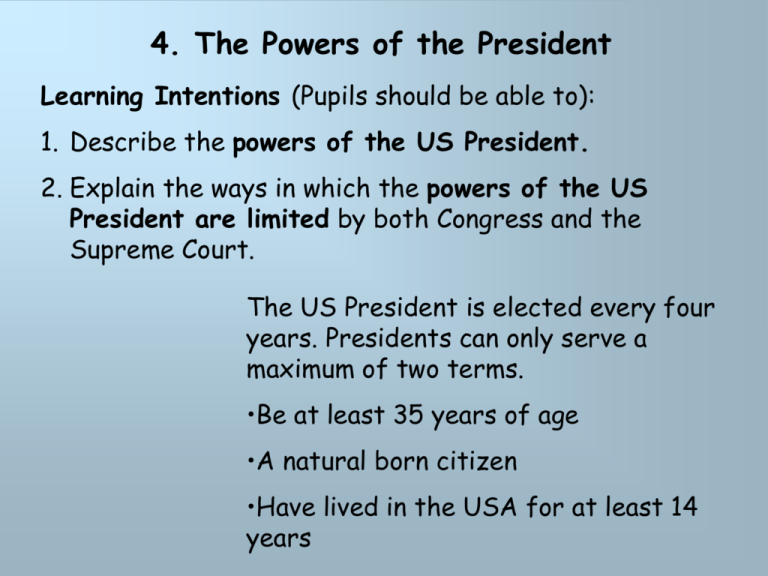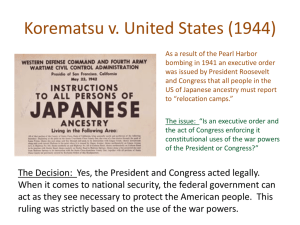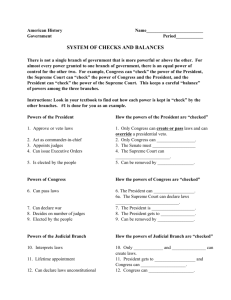powers of the US President are limited
advertisement

4. The Powers of the President Learning Intentions (Pupils should be able to): 1. Describe the powers of the US President. 2. Explain the ways in which the powers of the US President are limited by both Congress and the Supreme Court. The US President is elected every four years. Presidents can only serve a maximum of two terms. •Be at least 35 years of age •A natural born citizen •Have lived in the USA for at least 14 years The Powers of the President Article 11 of the US Constitution defines the powers of the US President. It states those powers the President can use without Congressional approval and those where he must seek Congressional approval. 1. Commander-in-Chief of the armed forces. Presidents have the responsibility for defending the USA (response to ‘Twin Towers’) including ordering troops overseas. However, only Congress can declare war e.g. in Iraq or Afghanistan. Treaties must also be approved by the Senate. 2. Power of appointment. The President appoints thousands of people to help run the country. These include members of the US Cabinet (e.g. Sec. of State John Kerry, etc.). However, nominations for overseas ambassadors and Supreme Court judges (Sonia Sotomayor) must have the approval of the Senate. The Powers of the President 3. Legislative Power Every January the President speaks to Congress in the State of the Union Address. As well as reviewing the previous year, the President outlines spending plans and any proposals for legislation. Note: Presidents cannot introduce legislation, only members of Congress have this right. Congress also controls the budget. • Power of veto. Before legislation becomes law, Bills must be signed by the President. If, however, the President disagrees with a new law he can refuse to sign e.g. Bush vetoed Stem Cell Research Bill 2006, Child Health Bill 2007 and ban on water torture 2008. Note: Congress has power to override the Presidential veto if a Bill is passed by two-thirds of the representatives of both Houses. The Powers of the President Powers of the President continued • Pocket veto. A ‘pocket veto’ or indirect veto is where a Bill remains unsigned by the President and there is insufficient time (i.e. less than 10 days before Congress adjourns) for Congress to reject the Presidential veto. Example: Obama returned a Bill unsigned to increase defence spending in 2009. • Executive Orders (EOs). The President can bypass Congress on certain occasions by issuing Executive Orders. EOs, in effect, allow the President to makes laws without Congressional approval. Under Bush, 262 EOs were issued. Obama has already issued a number of EOs including a review of the Guantanamo detainees and the ending of unlawful interrogation techniques. Note: Congress can impeach or remove a President if they suspect any wrongdoing although use of this power this is very rare. The Powers of the President Executive Orders (EOs) President Obama has released an executive order aimed at enhancing the nation's ability to defend against electronic attacks. Congress can override an EO with a two thirds majority vote Lesson Starter • Make a diagram which briefly outlines the powers of the President. The Powers of the President As the only person elected by all Americans, Presidents have enormous power. In particular, popular Presidents with a like-minded Congress, have used their support to increase their power. After the 9/11 attacks, Bush extended the power of the Presidency by creating the Department of Homeland Security. In order to fight terrorism, Bush argued, it was necessary for the President to have greater powers of surveillance, arrest and detention. But with the passing of the Patriot Act (2001), some commentators argued that Presidential power had gone too far as this Act gave the Attorney General the power to arrest anyone the authorities suspected of terrorism even if the courts disagreed. Note: In 2005, Congress checked the power of the president when it refused to renew some parts of the Patriot Act although much of it remains in place today. The Powers of the President The Supreme Court The Supreme Court can also act as a check against the power of the President and Congress. This is because the Supreme Court has the power of judicial review and it can decide that any law passed by the President and Congress is unconstitutional and therefore it cannot be applied anywhere in the USA. A decision of the Supreme Court cannot be appealed by any other court. Landmark rulings: Affordable Care 2012 In June 2012 the US Supreme Court upheld the Affordable Care Act, which allows the Federal government to force states to enforce the provisions of the affordable Care Act, socalled "Obamacare." Membership of the Supreme Court The Supreme Court If a Supreme Court judge retires or dies, the incumbent President can nominate a replacement. In August 2009 Sonia Sotomayor became the first Hispanic Justice on the Supreme Court after the Senate approved President Obama's nomination of her. In August 2010, Elena Kagan became President Obama's second appointment to the Supreme Court. Judges though are not supposed to be partisan party appointees. Legislative Branch •Checks on the executive •Power to declare war •May override presidential vetoes •Senate approves appointments •Checks on judiciary •Senate approves federal judges •Power to initiate constitutional amendments Executive Branch Judicial Branch •Checks on legislator •Vice President is the President of the Senate •Power to use veto •Checks on judiciary •Power to appoint judges •Pardon power •Guardians of the constitution •Checks on legislator •Judicial review- ability to declare a law unconstitutional •Checks on the executive •Checks decisions made by the president follow the rules laid down by the constitution •Power to impeach President Example The president can propose changes in law but it is Congress to pass these changes and present laws on behalf of the president. However the President must sign laws. If the president refuses to sign laws and uses the veto it could be difficult for Congress to pass the new law. Having said this, if the law is passed by Congress and signed by the President, the Supreme Court can still deem it unconstitutional and prevent it from being upheld in the USA. Congress As the Executive and Legislator are elected separately, there is not a guarantee that the President’s party will have control over their party in the Legislature. Senate: Democrat HoR: Republican Obama’s Health Bill Able to pass bill as Congress was controlled by the Democrats. Obama was also able to appoint a Latino Liberal Judge to the Supreme Court as he had a Democrat Congress. Had the Republicans controlled it, they would have blocked this appointment. Essay Question and KU Question • To what extent can Congress and the Supreme Court limit the powers of the President? • Explain, in detail, the powers of the president. (8 marks)








